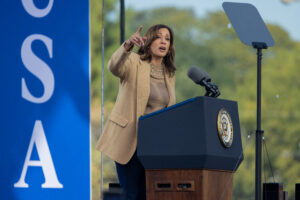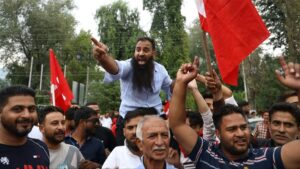Secularists and socialists helped Hindu communalism grow in India
Congress nomination of Kathua rape supporter Lal Singh to contest elections shows that secular parties give refuge to communalists when tide turns against them
By Iftikhar Gilani
The secular Congress party’s nomination of Chaudhary Lal Singh, a former minister for the Udhampur-Doda constituency in Jammu and Kashmir to contest the 2024 general elections, is poking a conundrum on those believing in secular ideals.
Recall the harrowing case of Asifa, the eight-year-old Muslim nomad girl from Kathua, whose rape and murder caused global outrage in 2018. Lal Singh, then a minister of the Hindu nationalist Bharatiya Janata Party (BJP), openly supported the rapists. He was later forced to resign from his post.
Now a member of Congress, Lal Singh embodies a disturbing pattern: once again demonstrating that secular parties are offering sanctuary to communal-oriented individuals when the political mood turns against them. This tendency raises profound questions about the integrity of secularism in the Indian political landscape.
The Bharatiya Janata Party (BJP)’s rise from a meager two seats in 1984 to over 300 seats in 2019 illustrates a calculated conquest of the electorate’s psyche that goes beyond the mere pursuit of votes.
Unlike the rightist parties in the world, the BJP after taking votes dictates on every front, from eating habits to choosing friends. According to Prashant Kishor, an election strategist, BJP imposes a psychological supremacy on its voters. In its quest for supremacy, it also tends to impose its values on minorities.
In his study of this political metamorphosis, journalist Qurban Ali reflects on the origins of communalism. In his two-part research paper, he argues that it was the secular Congress and the socialists who gave refuge to Hindu nationalism and allowed it to grow to monstrous proportions. In this endeavor, this monster later devoured them too.
Up until three decades ago, socialists in India wielded significant influence and stood as formidable adversaries to the then-ruling Congress party. They also held power in numerous Indian states as an alternative to the Congress.
Key figures in the socialist movement, such as Jayaprakash Narayan, Ram Manohar Lohia, and Kamala Devi Chattopadhyay, called for the prohibition of sectarian Hindu organizations following the assassination of Mahatma Gandhi in 1948. They denounced the ultra-Hindu nationalist Rashtriya Swayamsevak Sangh (RSS) as the source of malevolence, attributing Gandhi’s murder to a perilous ideology in need of firm suppression.
However, by 1975, Jayaprakash Narayan’s stance shifted. He suggested that if the RSS were fascist, then so were they. Lohia rescinded the ban on engagement with the RSS, and Jayaprakash Narayan embraced cooperation with them.
In 1998, socialist leader George Fernandez played a pivotal role in getting the political arm of the RSS, the BJP, to power by stitching various alliances.
In 2014, the BJP secured a majority on its own, propelled by the leadership of Narendra Modi. By this time, the BJP did not need the shoulders of socialist. Their influence had dwindled, with many of their leaders, including Ram Vilas Paswan and Nitish Kumar, rubbing noses before Modi. While the socialists succeeded in toppling the Congress from power in 1977 and 1989, they inadvertently empowered a force that swiftly devoured them.
Today, few in India are familiar with socialist parties like the Janata Party, Lok Dal, Forward Bloc, Sanyukta Socialist Party, and Praja Socialist Party etc., which once stood as formidable political entities and primary adversaries to the Congress.
-Congress and communalism
India’s first Prime Minister Jawaharlal Nehru had termed communalism as the biggest threat to the country. At a meeting of the All-India Congress Committee in 1958, Nehru termed communalism of the majority class as the biggest threat to the country. But over time, his own Congress party stoked imaginary fears in the Hindu majority to make them feel vulnerable and polarized.
The change was palpable under Indira Gandhi and reached its zenith with her son, Rajiv Gandhi during their premiership. Indira Gandhi’s rule marked a departure from Nehru’s secularism, and her association with the RSS had become quite apparent.
The RSS is an umbrella organization of Hindu nationalists. It has dozens of branches operating in different areas. It should be noted that the BJP is its political wing.
As a result, Rajiv Gandhi was the last Congress prime minister to rule the country with his majority. The next two Congress governments under Narasimha Rao and Manmohan Singh were dependent on the support of allies.
In his essay ‘How the Congress legitimized the Rashtriya Swayamsevak Sangh i.e. the communal politics of the RSS’, Qurban Ali states that the RSS allegedly helped the Congress win the 1980 and 1984 elections.
According to Ali, the famous Dalit leader Jagjivan Ram, who contested the 1980 elections as the Janata Party’s prime ministerial candidate, said after the election results that Indira Gandhi used the Hindu card to outwit him and come to power.
To stay in power, Indira Gandhi made extensive use of the crutch of religion. Besides visiting temples across the country, many sadhu saints, including yoga guru Dharendra Brahmachari, were given access to the corridors of power. She now began to seek advice from astrologers in everything she did.
Quoting several political analysts, Ali says that Indira Gandhi’s slogan of poverty alleviation had lost its effectiveness. So, a new slogan was needed to woo the voters and so he started playing the Hindu card.
In 1981, some 800 Dalits in Meenakashipuram, Tamil Nadu, had had enough of the atrocities of the upper Hindu castes and embraced Islam.
In an interview with the New York Times, Indira Gandhi attributed the incident to petrodollars from the Gulf States. She said that the dollars from the Gulf States encouraged poor Hindus to convert.
In the 1983, assembly elections in Jammu and Kashmir, Indira Gandhi openly used the Hindu card. For the first time, someone used a political advantage by polarizing the Hindu-majority Jammu against the Muslim-majority Kashmir Valley in such a sensitive region.
As prime minister, she personally took charge of the Congress election campaign and stayed in Jammu for nine days. The entire Prime Minister’s Office was shifted to Jammu.
In 1991, socialist leader Madhu Dandavate wrote that Indira Gandhi had told Hindu voters at a rally in Jammu that their lives and property were in danger. She was clearly referring to the political parties based in the Kashmir valley and stoking fears within Hindu population.
She was telling the Hindu voters in Jammu that only the Congress can protect them. To the Muslims in the Kashmir Valley, she conveyed the message that their future is not safe in the shadow of Indian democracy.
All the seats in Jammu fell to the Congress in these elections, but the situation changed rapidly thereafter, culminating later in the armed movement of 1989. Indira Gandhi had left her mark on the whole thing. The RSS openly supported the Congress in these elections.
Similarly, in 1984, in a speech at Garhwal after the Indian army had raided the Sikh holy shrine Golden Temple in Amritsar, Indira Gandhi said that Hinduism was under attack. She made a strong call to protect Hindu civilization from the attacks of Muslims and Sikhs.
A few months after her return to power in 1980, anti-Muslim violence broke out in Moradabad on Eid day, in which more than a hundred Muslims were killed. The Muslims had protested against pigs being brought into the Eidgah during prayers.
This was followed by a series of riots. Bihar Sharif, Meerut, the town of Baroda in Gujarat, and Bhiwandi on the Mumbai border were stained with Muslim blood, and the Congress ruled in all these places.
In 1983, more than 2,000 Muslim Bengalis were massacred in Neeli in Assam. Hardly anyone was punished for this massacre. Indira knew that he had suffered a defeat in the 1977 elections because of the Muslims. Did she want to take revenge on them?
-Hand in gloves with communal forces
According to Ali, Indira Gandhi met RSS leaders three times between 1982 and 1984. She extended support to the Ram Mandir campaign of the Vishwa Hindu Parishad (VHP), another branch of the RSS.
Citing the journalist Neerja Chaudhary, Ali reports that the leader of the VHP Ashok Singhal, told her in 1986 that Indira had assured him that she would make the Ram temple an election issue at the right moment. When the Ram Mandir campaign was first discussed in 1983, Congress leaders Devi Dayal Khanna and Gulzarilal Nanda attended the meeting.
In January 1986, during Prime Minister Rajiv Gandhi’s tenure, when the Babri Masjid was opened and Hindus were allowed to pray there, RSS chief Muralidhar Deoras described Rajiv Gandhi as the “King of Hindu Hearts.”
Rajiv Gandhi’s advisor Arun Nehru believed that he could attract Hindu voters by opening the locks of the Babri Masjid. Earlier, Parliament had overturned the Supreme Court’s decision on triple talaq to appease the Muslims.
As a balancing act, a move was now needed to appease the Hindus and so the Babri Masjid was opened for worship.
Similarly, an epic serial on the Ramayana was aired on the state television channel Doordarshan. This added fuel to the Ram Mandir movement. The then Minister for Information and Broadcasting, HKL Bhagat had strongly opposed it, saying it would unleash the poison of communalism and open Pandora’s box.
Similarly, in 1989, the foundation of Ram Mandir was laid by no one else but by Rajiv Gandhi himself at the request of the RSS. On the occasion, Rajiv Gandhi said that if he came to power again, he would declare Ram Rajya.
But the Congress lost the elections. Its tally in the parliament was drastically reduced from 414 to 196 seats. In 1990, when the Congress-backed government of Prime Minister Chandrashekhar was making serious efforts to find a solution to the Babri Masjid issue, RSS leaders again met Rajiv Gandhi and urged him to withdraw support from the government.
He was told that Chandrasekhar would become a hero if this issue was solved. The RSS had a clear plan to use the Ram Mandir movement politically to pave the way for the BJP. If this issue was resolved, the very purpose of the RSS would be defeated.
-Deserting Congress, supporting BJP
Meanwhile, the RSS had decided to withdraw its support from the Congress and bring its political wing, the BJP, to power and strengthen it politically. In these elections, the BJP had jumped from two seats to 85 seats.
This blurring of boundaries set a precedent that led to today’s political polarization. The Congress’s use of the Hindu card, the Ram Mandir campaign, and the allowing religious epics on state television — all actions that fanned the communal flames — demonstrate this.
The consequences of these actions are not only historical but also impact current politics.
The BJP’s national spokesperson associates monumental events such as the demolition of the Babri Masjid and the construction of the Ram Temple with economic prosperity — a narrative that comes dangerously close to justifying communal aggression for material gain.
Just recently, the national spokesperson of the BJP, Sidhanshu Trivedi, was telling a press briefing that the demolition of the Babri Masjid and the construction of the Ram temple was linked to the economic development of India.
He said that when the mosque was demolished in 1992, India’s foreign exchange reserves stood at one billion dollars. When the Department of Archeology excavated the ruins of the mosque in 2003 to determine whether it had been built over a temple, the foreign exchange hit $100 billion.
“When the Supreme Court handed over the land of the demolished mosque to Hindus and cleared the way for the construction of the Ram temple, the foreign exchange hit $500 billion, and when Prime Minister Narendra Modi inaugurated the temple in Ayodhya earlier this year, foreign exchange reserves reached 600 billion dollars,” he said.
That means, if the VHP’s list of 25,000 mosques they claim are demolished and converted into temples, India’s forex reserves will hit the roof.
In a way, this statement was a formal incitement and a kind of direction to target other places of worship.
Secularism in India was only a superficial phenomenon that is now also in crisis.
The model of Gandhi and Nehru is broken. The quagmire has deepened with the rise of Narendra Modi in the last two decades.
If the Congress wants to embark on a path of genuine secularism, it cannot run with hair and hunt with hounds by sending people like Lal Singh to Parliament as MPs and then wooing secular and Muslim votes.
The only way for the Congress or its leaders to pull the country out of this quagmire is by taking the communalists head-on. There is a need to learn from the fate of the socialists who compromised and were finished from the political landscape.
The party also needs to learn the fate of its own leaders and hold Indira Gandhi and Rajiv Gandhi accountable for appeasing communalists.
Otherwise, the monster of communalism is ready to devour and digest the Congress and Modi’s dream of a Congress-free India will be realized.










